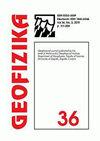利用广义加性模型量化萨格勒布当地气象对空气质量的影响
IF 1.1
4区 地球科学
Q4 GEOCHEMISTRY & GEOPHYSICS
引用次数: 17
摘要
本文报道了2006-2012年克罗地亚萨格勒布当地气象对选定空气污染物(一氧化碳(CO)、二氧化硫(SO2)、二氧化氮(NO2)和空气动力学直径高达10 μm的颗粒物(PM10)每小时平均浓度的响应估计。本文采用一种新的方法对萨格勒布市区进行了分析。在一般模型中,每小时平均空气污染物浓度的对数表示为气象变量和几个时间变量的非线性函数的总和,其中后者包括考虑排放的时间变化。该模型可以在广义加性模型(GAMs)的框架内进行表述,并且在对数尺度上是加性的,在原始尺度上产生乘法效应。虽然该模型是非线性的,但它简单且易于解释。它量化了气象条件和排放对空气污染的影响。每个预测因子的相对重要性的度量,部分效应和模型的统计评价也被提出。总体而言,结果表明,最重要的预测因素是与排放有关的预测因素。模式中气象变量的综合影响解释了CO的45%、SO2的14%、NO2的25%和PM10的24%的方差。这表明气象学,至少在当地尺度上,是萨格勒布空气质量的显著驱动因素。城市地区稳定的大气条件有利于出现较高浓度的空气污染物。在不稳定条件下对流过程占主导地位,导致边界层内污染物浓度的稀释。本文章由计算机程序翻译,如有差异,请以英文原文为准。
Using a generalized additive model to quantify the influence of local meteorology on air quality in Zagreb
This paper reports the estimated response of hourly mean concentrations of selected air pollutants, namely carbon monoxide (CO), sulphur dioxide (SO2), nitrogen dioxide (NO2) and particulate matter with an aerodynamic diameter of up to 10 μm (PM10), to local scale meteorology in Zagreb, Croatia for the period 2006–2012. A new method is applied here for the urban area of Zagreb. In a general model, a logarithm of hourly mean air pollutant concentrations is expressed as the sum of the nonlinear functions of meteorological and several time variables, with the latter included accounting for temporal variation in emissions. The model can be formulated within the framework of generalized additive models (GAMs) and is additive on the logarithmic scale, which results in multiplicative effects on the original scale. Although the model is nonlinear, it is simple and easy to interpret. It quantifies the impact of meteorological conditions and emissions on air pollution. A measure of the relative importance of each predictor, partial effects and statistical evaluation of the model are also presented. Overall, the results show that the most important predictors are those related to emissions. The aggregate impact of meteorological variables in the model explained 45% of variance in CO, 14% in SO2, 25% in NO2 and 24% in PM10. This indicates that meteorology, at least on a local scale, is a noticeable driver of air quality in Zagreb. Stable atmospheric conditions in the urban area favour the occurrence of higher concentrations of air pollutants. Convection processes dominate under unstable conditions, resulting in the dilution of pollutant concentrations within the boundary layer.
求助全文
通过发布文献求助,成功后即可免费获取论文全文。
去求助
来源期刊

Geofizika
地学-地球化学与地球物理
CiteScore
1.60
自引率
0.00%
发文量
17
审稿时长
>12 weeks
期刊介绍:
The Geofizika journal succeeds the Papers series (Radovi), which has been published since 1923 at the Geophysical Institute in Zagreb (current the Department of Geophysics, Faculty of Science, University of Zagreb).
Geofizika publishes contributions dealing with physics of the atmosphere, the sea and the Earth''s interior.
 求助内容:
求助内容: 应助结果提醒方式:
应助结果提醒方式:


